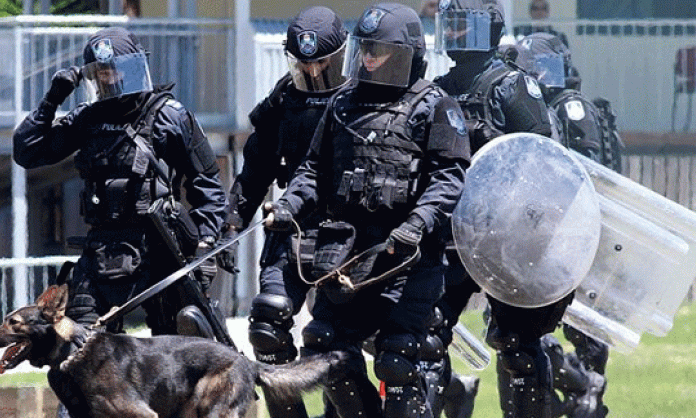It began several weeks before the opening of the G20 festival of reaction; a media binge of anti-protest hysteria. Seizing on provocative press releases from the Queensland assistant police commissioner, Katarina Carroll, media outlets did their best to justify the thousands of cops and soldiers being mobilised, to say nothing of the trashing of civil liberties for the conference’s duration.
On 28 October, the front page of the Courier Mail screamed “Battle of Brisbane” and “exclusive: cops vow to crush G20 ferals”. The website declared: “Troublemakers to be banned under special Queensland legislation”. Carroll had identified all of two “trouble makers” who would be banned from the security zone.
The Courier and the Brisbane Times, in identical paragraphs, revealed: “Magistrates are to be rostered around-the-clock to run a special week-long G-20 court expected to deal with potentially mass arrests.” The 24/7 court would commence five days before the G20 started, “with police bracing for possible violence when protesters take to the streets”. Police press release perhaps?
Stories relied on repetition of tiny snippets of information – the salient points often restated three times in one article and over days. You could not mistake the cops’ intentions to be “very swift” in their action “if there is damage, if anyone is hurt”. On this theme, the Times asserted that Carroll said some protest groups are “formidable in size”. But in their enthusiasm for repetition of key points, it became clear that formidable was their translation for her “larger numbers”.
From occasional 10-second grabs of protest organisers, the evidence is that the protests are intended to be peaceful. The Facebook page “G20 people’s march” declares it is a “peaceful, family-friendly event”. A spokesperson for Occupy Brisbane and BrisCAN-G20 days before had told the Brisbane Times:
“We are not out there to cause trouble … We would rather stimulate a positive debate … we want to get people questioning the existing paradigm. But we don’t want to replace it with one that is just as violent.”
The ninemsn website quoted an organiser of an anti-Putin rally: “Our intention is to have a peaceful rally”, followed immediately by “police said they will act if protests turn violent”.
But in the age of terrorism and draconian anti-terror laws, what better footage for the media to show than a “Spectacular Brisbane G20 anti-terror exercise”: Black Hawk helicopters, gun-toting special forces scaling ropes dangling dangerously, smoke billowing as they staged a mock hostage situation on the wharves of Brisbane, now an “urban conflict zone”. The next day it was “intelligence reports” of threats to “soft” targets.
With no evidence of planned violent protests, they began a frenzy of fear-mongering about international Black Bloc activists intending to cause “chaos”, based on vague speculation by a Griffith academic. Channel Ten’s Project pronounced: “Police and protesters prepare for G20 showdown”. Fear of mass arrests was embellished with photos of burning cars and headlines like “Will the carnage of Toronto 2010 be repeated?”
Whether intentionally or by accident, graphics and text on the Channel Seven website turned hysteria into irony. Under a photo of hundreds of riot cops, this caption appeared:
“Those who subscribe to their views are encouraged to dress in black, wear hoodies, sunglasses and ski-masks, and bring motorcycle helmets to protests. ‘Black Bloc protesters are ready for violence’, Professor Williams explains.”
Above a similar photo, we read that a wise professor Lauch intoned: “We shouldn’t be worried because they dress in black they’ll be violent, but it’s human nature that the violence will come, and it will come from angry young men, who join all sorts of groups and get caught up in the moment and participate in violence.” Need we say more?









